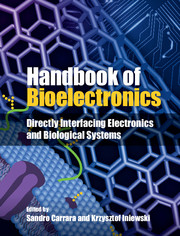Book contents
- Frontmatter
- Contents
- List of Contributors
- 1 What is bioelectronics?
- Part I Electronic components
- Part II Biosensors
- Part III Fuel cells
- Part IV Biomimetic systems
- Part V Bionics
- Part VI Brain interfaces
- 27 Introduction to brain–machine interfaces
- 28 ECG technology for the brain–machine interface
- 29 Reducing the implant footprint: low-area neural recording
- 30 Electrical stimulation
- 31 Biological channel modeling and implantable UWB antenna design for neural recording systems
- 32 Intracranial epilepsy monitoring using wireless neural recording systems
- 33 Low-power building blocks for neural recording systems
- 34 CMOS circuits for intracellular brain–machine interfaces
- Part VII Lab-on-a-chip
- Part VIII Future perspectives
- Index
- References
33 - Low-power building blocks for neural recording systems
from Part VI - Brain interfaces
Published online by Cambridge University Press: 05 September 2015
- Frontmatter
- Contents
- List of Contributors
- 1 What is bioelectronics?
- Part I Electronic components
- Part II Biosensors
- Part III Fuel cells
- Part IV Biomimetic systems
- Part V Bionics
- Part VI Brain interfaces
- 27 Introduction to brain–machine interfaces
- 28 ECG technology for the brain–machine interface
- 29 Reducing the implant footprint: low-area neural recording
- 30 Electrical stimulation
- 31 Biological channel modeling and implantable UWB antenna design for neural recording systems
- 32 Intracranial epilepsy monitoring using wireless neural recording systems
- 33 Low-power building blocks for neural recording systems
- 34 CMOS circuits for intracellular brain–machine interfaces
- Part VII Lab-on-a-chip
- Part VIII Future perspectives
- Index
- References
Summary
Neural recording
Neural recordings have been utilized for controlling brain–machine interfaces, such as artificial arms, since the late 1960s [1]. Neural recording devices play a central role in paralysis prosthetics, stroke, Parkinson’s disease, prosthetics for blindness, and experimental neuroscience systems. Several attempts have been conducted in recent years to implement large-scale multi-electrode neural recording [2], [3]. Experiments have been conducted on a variety of species ranging from rats [4] and monkeys [5] to humans [6].
Figure 33.1 shows how a brain–machine interface (BMI) can help several patients. Figure 33.1(a) shows conceptually how BMIs can help patients who suffer from damaged arm muscles, preventing the signal from reaching the brain, or those who have artificial limbs [7]. Vivid examples of recent efforts in using BMIs to help paralyzed patients include the thought control of a wheelchair [8], as seen in Figure 33.1(b), and thought control of a robotic arm by a patient suffering from paralysis for 15 years [9], as shown in Figure 33.1(c). However, better quality of life could be imparted to these patients if a fully implantable wireless solution was available.
Figure 33.2 shows an illustrative picture of a brain implant system. The implant’s power is wirelessly harvested to allow battery-free operation. Wireless transmission is necessary to allow for non-invasive operation.
- Type
- Chapter
- Information
- Handbook of BioelectronicsDirectly Interfacing Electronics and Biological Systems, pp. 400 - 413Publisher: Cambridge University PressPrint publication year: 2015



